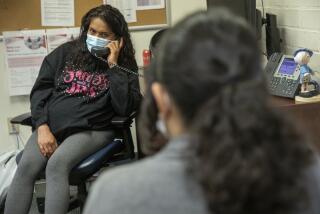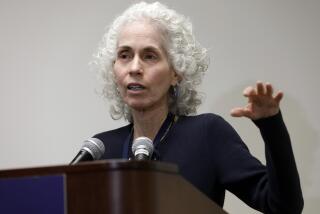Uninsured a Growing Burden for the County : Finances: The number of medical center patients without coverage reached 35% in June. Officials fear a funding shortage as fewer employers provide health insurance.
A traffic accident in July sent Oxnard resident James Wald to the hospital with nine broken ribs and a fractured pelvis.
Caught off-guard with no insurance, Wald was transferred from Los Robles Regional Medical Center in Thousand Oaks to the county hospital, where he later underwent surgery for a collapsed lung. He estimates his total bill could top $30,000--with taxpayers picking up the tab.
Wald, 41, said he doesnât like having to depend on the government for medical care. But he said he cannot afford a health insurance premium despite working full-time as an electrician.
âIt makes me feel like less of a man to say, âI canât afford to pay you, but Iâm dying. Can you help me?â â
Wald is one of a growing population in the county: people who are employed but have no medical insurance and must rely on the public hospital system as their safety net.
Last year, Ventura County Medical Center provided $22 million worth of care to patients who were unable to pay, officials said.
Concerned about the increasing financial burden on the county system, hospital officials recently began to closely track the number of uninsured patients they see each month.
And they are alarmed at what they are finding. Of the 824 patients treated at the county hospital during May, 183, or 22%, were uninsured. That number jumped to 287, or 35%, in June.
âThe numbers are astounding,â said Dr. Samuel Edwards, medical director of the county hospital. âWe donât have the money or the capability to take care of everybody.â
Although it is too early to make accurate projections, Edwards and other county health officials speculate that as much as one-third of the countyâs population under age 65--165,000--may be uninsured.
âThis represents a long-term threat because there is no funding [to cover] this new population,â said Pierre Durand, director of the countyâs Health Care Agency. âItâs something we have to deal with.â
Ventura Countyâs situation is a reflection of the ongoing decline in employer-provided health coverage throughout the state, officials said.
A study released this year by the UCLA Center for Health Policy Research found that the number of uninsured Californians reached 6.5 million, or 23% of the non-elderly population, in 1993. That compared with a national average of 18.3%.
The report also showed that California employers paid 51.5% of the health insurance for people under the age of 65, down from 56% in 1989.
The drop in employer-provided health coverage is attributed in part to the recession and declining incomes of working families and individuals, said E. Richard Brown, director of the center and author of the study.
*
Another reason for the decline is Californiaâs move during the past decade away from manufacturing toward a more service-oriented economy, Brown said. This means there are more small businesses that cannot afford to provide health insurance, he said.
âItâs very competitive in the service industries, so there are few incentives for employers to offer insurance,â he said. âWhy would an employer add to his labor costs when his competitor is not?â
Even when an employer does offer insurance, it doesnât necessarily mean that the employee will take it, Brown said.
âNot all people take it because they canât always afford it,â he said. âSay youâre in a family of four and youâre earning $24,000 a year, itâs tough to buy insurance.â
Durand said the result is that taxpayers must pick up the bill for the uninsured. He said the problem is exacerbated because many of them, like Wald, are not poor enough to qualify for Medi-Cal--government-paid insurance for the stateâs poorest residents.
Miguel Montano, a 27-year-old resident of Oxnard, is another example of those who depend on the countyâs health safety net.
Montano, who recently started a produce-delivery business, suffered a fractured nose and a hip injury in a traffic accident in Encino last month. After Montano underwent surgery on his hip, doctors at the private San Fernando hospital where he was treated sought to transfer him to Ventura County Medical Center because he had no insurance. âThey were concerned outright about the money,â said Patty Lopez, Montanoâs fiancee.
Since his arrival at the county hospital two weeks ago, Montano has run up more than $10,000 in bills. Edwards, the hospitalâs medical director, said that cases such as Waldâs and Montanoâs are not uncommon. âIâve seen cases where the bills have gone as high as $98,000,â he said.
Edwards also stressed that the uninsured are not just the poor. In many cases, he said, they are college educated with good jobs.
âAsk a group of your friends and youâre going to find out many of them donât have insurance,â Edwards said. âIf you invite six people to dinner, theyâre half the people at your table.â
To help cover the cost of treating the uninsured, the county hospital depends on a number of funding sources.
This year they include a $3.8-million county subsidy, $6 million in special motor vehicle registration fees, $4 million in local sales tax money and $9.2 million in matching state and federal funds from the Disproportionate Share hospital program. To qualify for the federal-state program, hospitals must have a Medi-Cal caseload of at least 42%.
*
The county hospitalâs Medi-Cal caseload is about 65%, largely because of its aggressive clinic expansion in recent years, officials said. As a result, the countyâs Medi-Cal reimbursements help offset its costs for treating those who cannot pay.
Edwards credited Durand with the successful expansion. There are seven health care clinics throughout the county, operated in partnership with private doctors.
âPierre is a wizard--nobody can do what he is doing,â Edwards said. âHe has expanded when everybody else has been forced to [reduce] their care for the poor.â
Yet, Edwards and Durand warned that government funding is threatened because of large state and federal deficits. Congress is considering either cutting funds or tightening eligibility requirements for Medi-Cal and Medicare--the federal health insurance for people over 65.
They also point out that the county cut its subsidy to the hospital this year by $1.6 million. Moreover, the amount of sales tax money and automobile fees that come to the hospital are largely dependent on the economy and until recently had been lagging.
So what is the solution?
Durand believes that as the uninsured population continues to grow, it will create economic opportunities for new and more innovative insurance programs. He said fierce competition has already driven down premiums charged by health-maintenance organizations.
Indeed, last week the Board of Supervisors agreed to switch to a new health care provider to cover 3,800 county employees. The reason is that Aetna Life Insurance offered a premium rate 3.1% lower than the previous carrier.
âI believe that through competition, insurance rates will continue to come down,â Durand said. âAnd I think in a matter of two or three years that the uninsured population, just by the mere numbers, will create an opportunity for some type of entrepreneurial insurance system.â
Both Edwards and Brown, who conducted the UCLA study, take a different view.
*
Despite President Clintonâs failed effort to push through a universal health care plan, they say such a guaranteed health program is the only answer.
They argue that insurance rates charged to small businesses have dropped significantly in recent years, yet fewer and fewer employers are covering their workers.
âUltimately, itâs going to come back to the government,â Brown said. âThe political will is not there now. But when we see more dissatisfaction among the public, then I think weâll see change. And that will happen as employer-funded health care continues to decline.â
More to Read
Sign up for Essential California
The most important California stories and recommendations in your inbox every morning.
You may occasionally receive promotional content from the Los Angeles Times.










